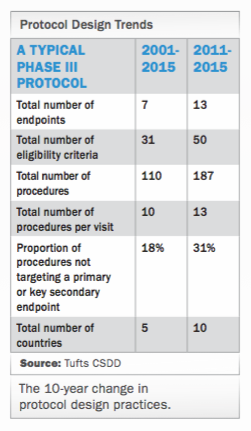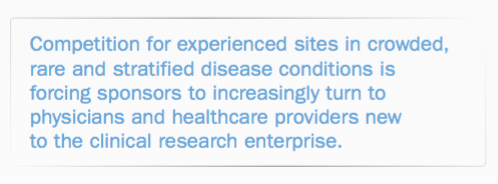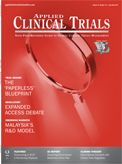The Elusive Goal of Optimizing Development Operations
Applied Clinical Trials
Examining the evolution of protocol design and collaboration executing strategies.
Despite best intentions, drug development operations remain highly inefficient and unpredictable. There are a number of fundamental factors driving these conditions, including complex protocol designs, poorly executed operating strategies and the failure to engage study volunteer and healthcare provider communities. I’ve touched on these factors in past Clinical Trial Insights. This
Ken Getz

column presents updated data characterizing protocol design and collaboration execution practices.
Let’s begin at the macro level looking at the high and rising financial and time-based cost of innovation. In 2017, close to $160 billion will be spent globally on R&D-a 4% average annual increase during the past decade. The out-of-pocket (direct) costs-adjusted for inflation-to develop a single approved drug is approaching $1 billion; 2.5 times the out-of-pocket R&D cost to develop a single approved drug 10 years ago.
The ever-increasing use of contract service providers and the implementation of new technologies and practices have had little-to-no impact accelerating development timelines. Clinical and regulatory durations-averaging 6.8 years and 1.6 years, respectively-are slower than those observed in the mid-1990s.
A key contributor to longer timelines is patient recruitment and retention. This is an extremely difficult task for clinical operations to execute effectively, efficiently and predictably. Based on company reports of thousands of clinical trial cycle times, across all therapeutic areas, actual recruitment timelines end up nearly double in duration than planned timelines. This reality is a function of the growing challenge of identifying, finding and attracting study volunteers, particularly in specific disease conditions where very targeted patient subpopulations are sought and in crowded disease conditions where the competition for study volunteers has intensified. The wide variances between actual and planned enrollment timelines are also a function of overly ambitious timelines set by clinical teams.
Even after planned timelines have been doubled, we see widely disparate enrollment achievement rates across participating investigative sites involved in a given clinical study. During the past decade, research from the Tufts Center for the Study of Drug Development (Tufts CSDD) shows that approximately 10% of all investigative sites will fail to enroll a single patient in a global multi-centered Phase III clinical trial. Approximately 40% of sites will be activated-requiring investment in monitoring, relationship and data management throughout the study-yet they will under-enroll, failing to recruit and retain the requisite number of patients. In the aggregate, the high cost of identifying, recruiting and managing non- and under-enrolling investigative sites represents a significant portion of overall study budgets.
Site management and performance is one of the most inefficient and unpredictable areas in clinical development. Study start-up timelines have increased by approximately 40% during the past 10 years. Tufts CSDD research shows very wide variability in cycle times for all study start-up activities-from site identification through to study completion. These variances are unprecedented given the volume of clinical trials initiated by mid-sized and major pharmaceutical and biotechnology companies each year. Budgeting and contracting, contract execution to site initiation, and site initiation to site activation processes are the most variable and unpredictable.
Complex protocol design execution
Without a doubt, protocol design complexity is the most fundamental driver of development operating conditions. Tufts CSDD studies conducted over the past two decades show high growth in the number of protocol endpoints, eligibility criteria and procedures performed overall and per study visit. Although the cost for many individual procedure has declined over time (e.g., ECG assessments; imaging), the overall direct and indirect cost per study volunteer visit has increased due to the larger number of procedures performed each visit.
To lower clinical trial costs and to reach large untapped patient populations and well-trained personnel, companies are placing their Phase II and III studies in more countries. At the same time, companies are engaging a larger number of investigative sites to each recruit a smaller number of patients. Taken together, sites have more difficulty achieving familiarity with the protocol and operating efficiency when they are only enrolling a few patients during the treatment duration of the study. This problem will grow as R&D pipelines increasingly focus on rare and specialty diseases.
Protocol complexity is positively correlated with longer cycle times and higher costs. Complexity is also associated with a higher incidence of amendments and change orders. The typical Phase III study has an average of 2.3 unplanned and unbudgeted amendments. Each amendment requires three months and $500,000 in direct cost to implement. The primary reason

for amending a protocol is to relax the eligibility criteria. And half of all amendments occur before the first patient has received the first dose, indicating that in our haste to put the protocol into the clinic we’re not spending enough time challenging the protocol’s executional feasibility. The number of reported change orders has also increased as protocol designs have become more complex (see chart).
A number of studies in the literature have shown that protocol complexity is associated with poorer data quality and integrity. The number of complaints that the FDA receives for investigative site non-compliance and fraud has also risen substantially since the mid-2000s. Protocol violations are the number one reason why complaints are filed against clinical investigators and may reflect the high execution burden that study staff must bear.
Inconsistent collaboration execution
This past year, of the nearly $148 billion spent on R&D, 55%, or approximately $80 billion, was spent globally on all forms of contract R&D services, including personnel, consultants, contract research organizations (CROs), contract manufacturing and investigative sites. During the past several years, pharmaceutical and biotechnology companies in the aggregate have spent more on contract R&D services than on their own internal staff and infrastructure. There is no indication that this trend will reverse.
Clinical operations activities are deeply dependent on collaborative effectiveness. Approximately $26 billion was spent on CROs in 2016 largely to execute clinical trial activity worldwide. And about $14 billion was spent on study grants to investigative sites. It is widely acknowledged that these two markets are integral to the success of clinical development activity. Yet our research and that of others continues to show that site and CRO performance remains mixed, inefficient and unpredictable.
Although the CRO market has been consolidating during the past decade with the largest 10 CROs now capturing 60% market share, it is the middle full-service CRO market that has been vanishing. A vibrant and growing market exists for niche and specialty service providers.
The investigative site market remains highly fragmented and nascent. As a result, we have seen virtually no scale economies or efficiencies. The number of private community-based physicians involved in conducting clinical trials continues to grow each year. Fragmentation-particularly on complex development programs-introduces project coordination and management inefficiencies, system and process integration and compatibility challenges.
Inconsistent collaboration is another fundamental driver of operating inefficiency. This area has much to do with the failure of sponsor companies to translate and enforce strategic intent into executional practice. Despite the fact that nearly all major sponsor companies have entered into at least one

strategic alliance, a very small percentage of CROs participate in development planning and protocol design. Sponsors also report that-although they are expected to work with preferred providers-they routinely mix and match the use of niche and full-service CROs to meet the needs of each individual study. And sponsors typically evaluate CRO performance and relationship effectiveness on measures that are at best joint responsibilities or that fall squarely in the sponsor’s camp.
Although advanced data- and evidence-based solutions are available, a large percentage of sponsor companies continue to rely on very unsophisticated approaches to identify and engage investigative sites. Competition for experienced sites in crowded, rare and stratified disease conditions is forcing sponsors to increasingly turn to physicians and healthcare providers new to the clinical research enterprise.
Optimization solutions
Sponsor companies are keenly aware of fundamental factors contributing to perennial operating conditions. Drug developers are actively evaluating, piloting and implementing new strategies and tactics (e.g., standardized and novel practices, technologies and collaboration models). And there has been a proliferation of solutions providers-and investors -focusing on new standalone and combined offerings designed to inform, enhance and accelerate drug development activity.
To name but a few areas: collective efforts to elevate the level of patient engagement in clinical trials holds promise in helping to simplify protocol designs; to target research activity on clinically meaningful benefits as defined by patients; to minimize participation burden and inconvenience; and to enlist stronger support from prospective study volunteers.
The use of advanced analytics of large structured and unstructured data-patient reports and real-time clinical and behavioral metrics-to better understand the course and impact of disease, how to treat it and to collect more comprehensive and meaningful insights into the safety and efficacy of investigational therapies is another promising area.
Lastly, perhaps the most transformative landscape development is the integration of clinical care and clinical research, supported by flexible and mobile technologies (e.g., smart phones and wearable devices), to bring clinical trials to wherever patients wish to and are best able to participate. This integration leverages healthcare infrastructure, telemedicine and the growing volume of electronic health information to identify patients quickly, recruit patients while they are receiving medical care and engage them seamlessly and conveniently.
All of these areas hold the potential to dramatically change the economics and duration of traditional drug development operations.
Ken Getz, MBA, is the Director of Sponsored Research at the Tufts CSDD and Chairman of CISCRP, both based in Boston, MA. email: kenneth.getz@tufts.edu
